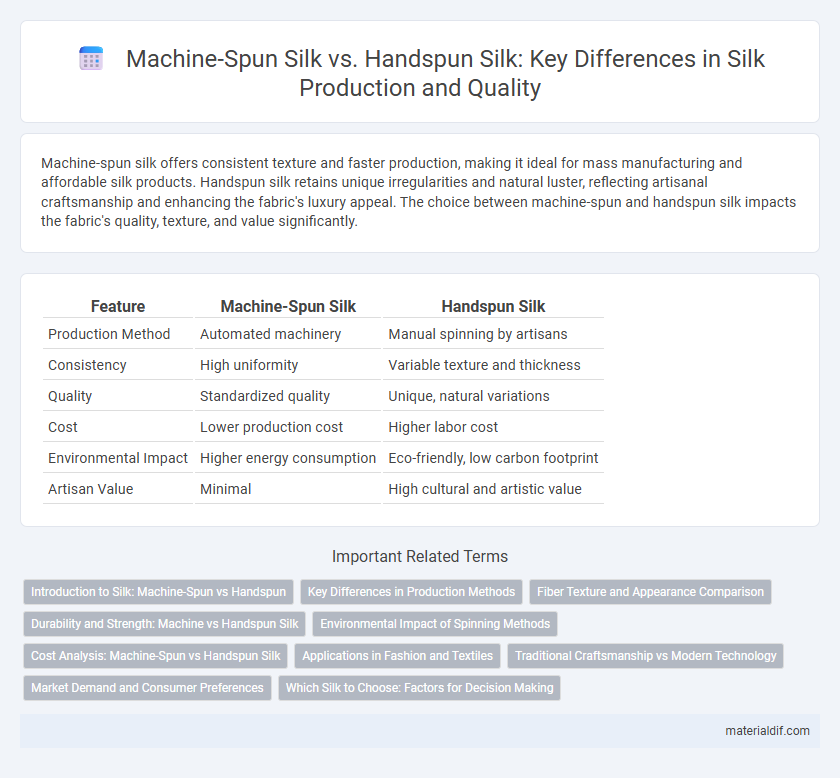Machine-spun silk offers consistent texture and faster production, making it ideal for mass manufacturing and affordable silk products. Handspun silk retains unique irregularities and natural luster, reflecting artisanal craftsmanship and enhancing the fabric's luxury appeal. The choice between machine-spun and handspun silk impacts the fabric's quality, texture, and value significantly.
Table of Comparison
| Feature | Machine-Spun Silk | Handspun Silk |
|---|---|---|
| Production Method | Automated machinery | Manual spinning by artisans |
| Consistency | High uniformity | Variable texture and thickness |
| Quality | Standardized quality | Unique, natural variations |
| Cost | Lower production cost | Higher labor cost |
| Environmental Impact | Higher energy consumption | Eco-friendly, low carbon footprint |
| Artisan Value | Minimal | High cultural and artistic value |
Introduction to Silk: Machine-Spun vs Handspun
Machine-spun silk is produced using advanced mechanized processes that ensure consistent thread thickness and high-volume output, making it ideal for large-scale textile manufacturing. Handspun silk, crafted by skilled artisans, exhibits unique variations in texture and strength, reflecting traditional techniques and cultural heritage. The distinct qualities of each type influence fabric appearance, durability, and market value in the global silk industry.
Key Differences in Production Methods
Machine-spun silk is produced using automated reels that unwind cocoons rapidly, ensuring high consistency and volume in thread thickness. Handspun silk involves manually extracting fibers with traditional tools, yielding irregular thread textures prized for artisanal quality and unique strength. The mechanized process prioritizes efficiency and uniformity, whereas hand spinning emphasizes craftsmanship and intricate fiber control.
Fiber Texture and Appearance Comparison
Machine-spun silk fibers exhibit a more uniform texture and consistent thickness, resulting in a smooth and even appearance across the fabric. Handspun silk displays subtle variations in fiber thickness and texture, creating a unique, slightly irregular surface that adds depth and character to the material. These differences in fiber texture directly influence the visual appeal, with machine-spun silk appearing sleek and polished, while handspun silk offers a natural, artisanal aesthetic.
Durability and Strength: Machine vs Handspun Silk
Machine-spun silk generally exhibits higher durability and consistent strength due to mechanized control over fiber alignment and tension during spinning. Handspun silk, while valued for its unique texture and artisanal quality, tends to have variable tensile strength and may be less uniform, making it more susceptible to wear and tear over time. Advances in spinning technology enhance machine-spun silk's performance in applications requiring robust, long-lasting fabric.
Environmental Impact of Spinning Methods
Machine-spun silk results in higher energy consumption and increased carbon emissions compared to handspun silk, which relies on manual labor and thus has a significantly lower environmental footprint. The mechanized process often involves synthetic lubricants and chemicals that contribute to water pollution, whereas handspinning uses natural fibers and minimal processing, reducing ecological harm. Choosing handspun silk supports sustainable production by minimizing resource consumption and promoting eco-friendly practices in the textile industry.
Cost Analysis: Machine-Spun vs Handspun Silk
Machine-spun silk offers a cost advantage due to higher production efficiency and lower labor expenses, resulting in more affordable pricing for bulk orders. Handspun silk involves intensive manual labor, specialized skills, and longer production times, which significantly increase its market value and appeal as a luxury textile. The price differential reflects these factors, with handspun silk commanding premiums driven by its artisanal quality and limited availability.
Applications in Fashion and Textiles
Machine-spun silk offers consistent texture and uniformity, making it ideal for mass-produced fashion garments and home textiles where durability and cost-efficiency are prioritized. Handspun silk provides unique irregularities and a natural sheen, favored in haute couture and artisanal textile crafts that emphasize exclusivity and artisanal value. The choice between machine-spun and handspun silk significantly influences fabric characteristics, wearability, and market positioning in the fashion industry.
Traditional Craftsmanship vs Modern Technology
Machine-spun silk offers increased production speed and uniformity, leveraging modern technology to meet high demand efficiently. Handspun silk preserves traditional craftsmanship through meticulous, labor-intensive techniques that enhance the fabric's unique texture and cultural value. The contrast between the two highlights the balance between industrial scalability and artisanal quality in silk production.
Market Demand and Consumer Preferences
Machine-spun silk dominates the global textile market due to its cost-efficiency and consistent quality, driving high consumer demand in mass-produced fashion and home decor sectors. Handspun silk appeals to niche markets where consumers prioritize artisanal craftsmanship, unique texture, and sustainable production methods, often commanding premium prices. Rising awareness of ethical fashion and slow textiles is shifting some demand toward handspun silk, although machine-spun silk remains the primary choice for affordability and large-scale availability.
Which Silk to Choose: Factors for Decision Making
Machine-spun silk offers consistent quality, faster production, and lower costs, making it ideal for commercial use and mass-market applications. Handspun silk provides unique texture, superior strength, and artisanal value, appealing to luxury markets and ethical consumers who prioritize craftsmanship and sustainability. When choosing silk, consider factors such as budget, end-use, desired fabric characteristics, and ethical preferences to determine the best option for your project.
Machine-spun silk vs Handspun silk Infographic

 materialdif.com
materialdif.com